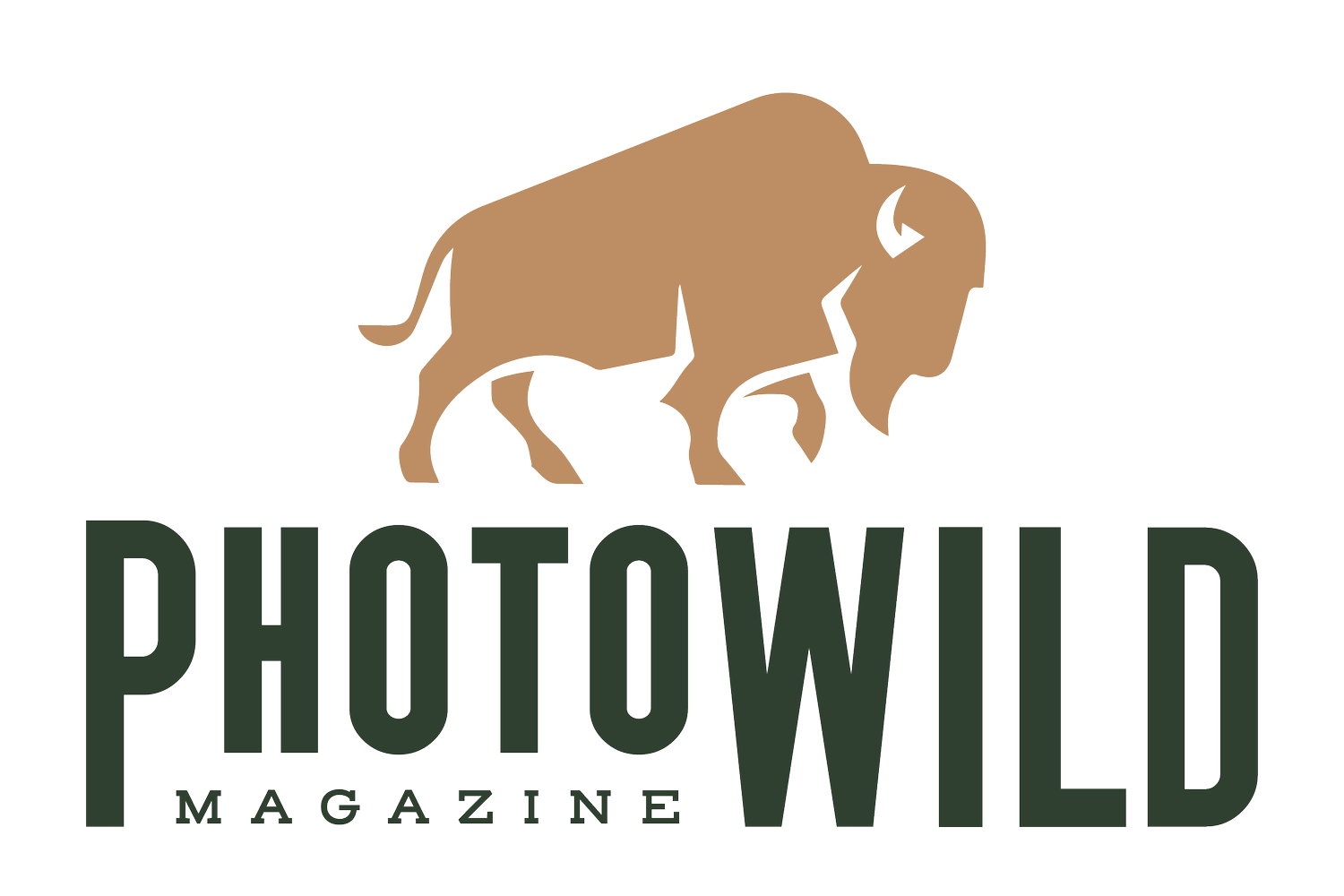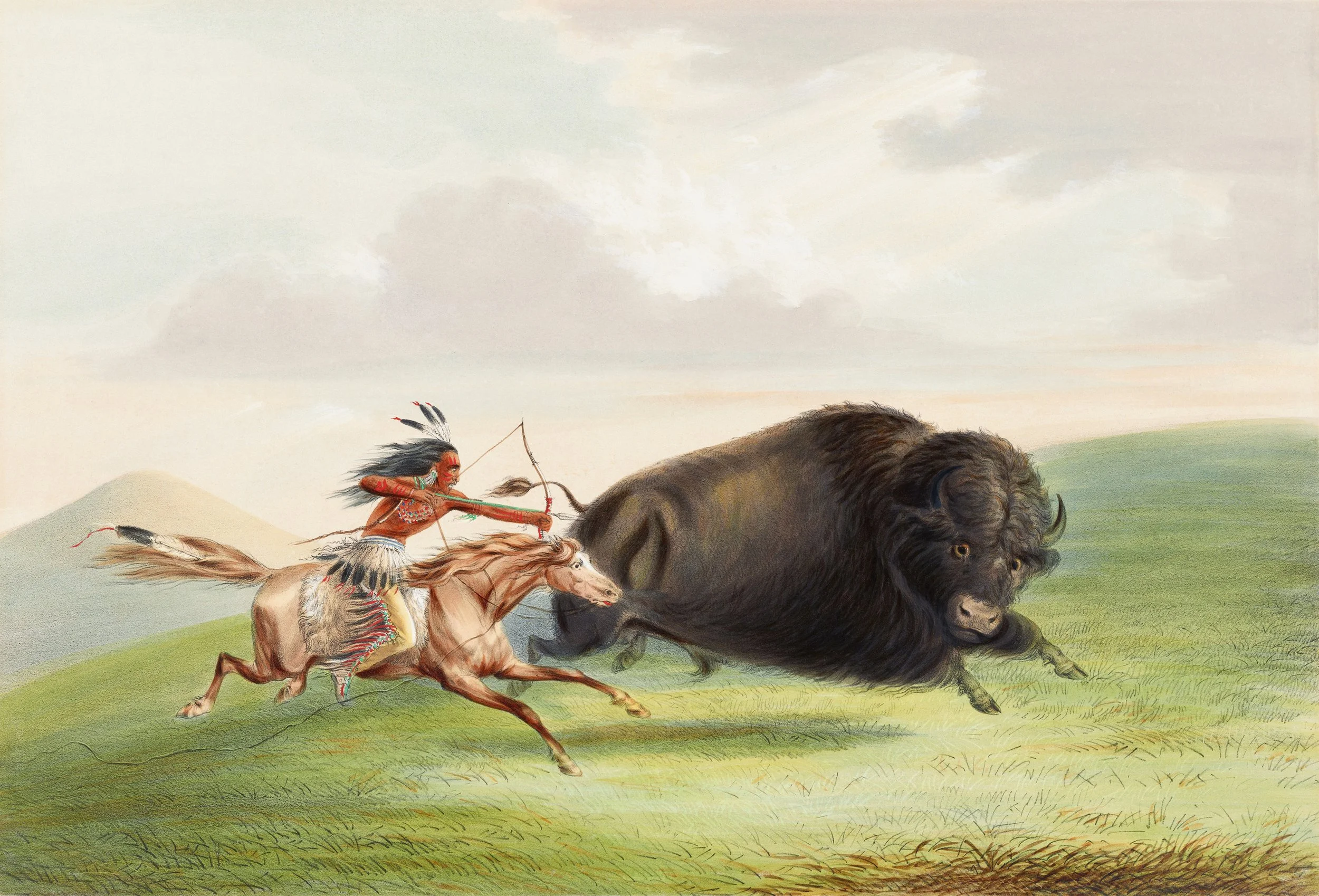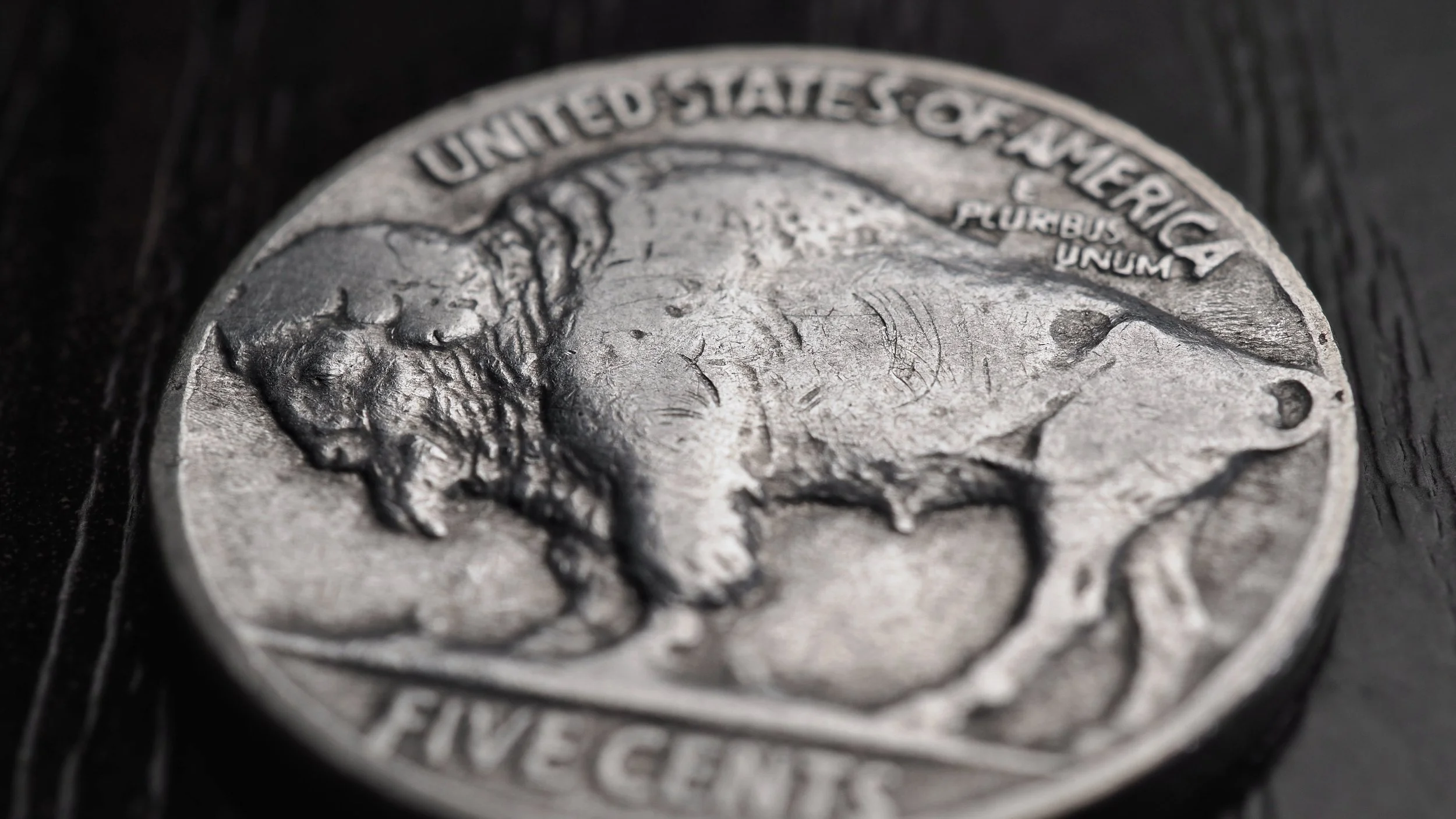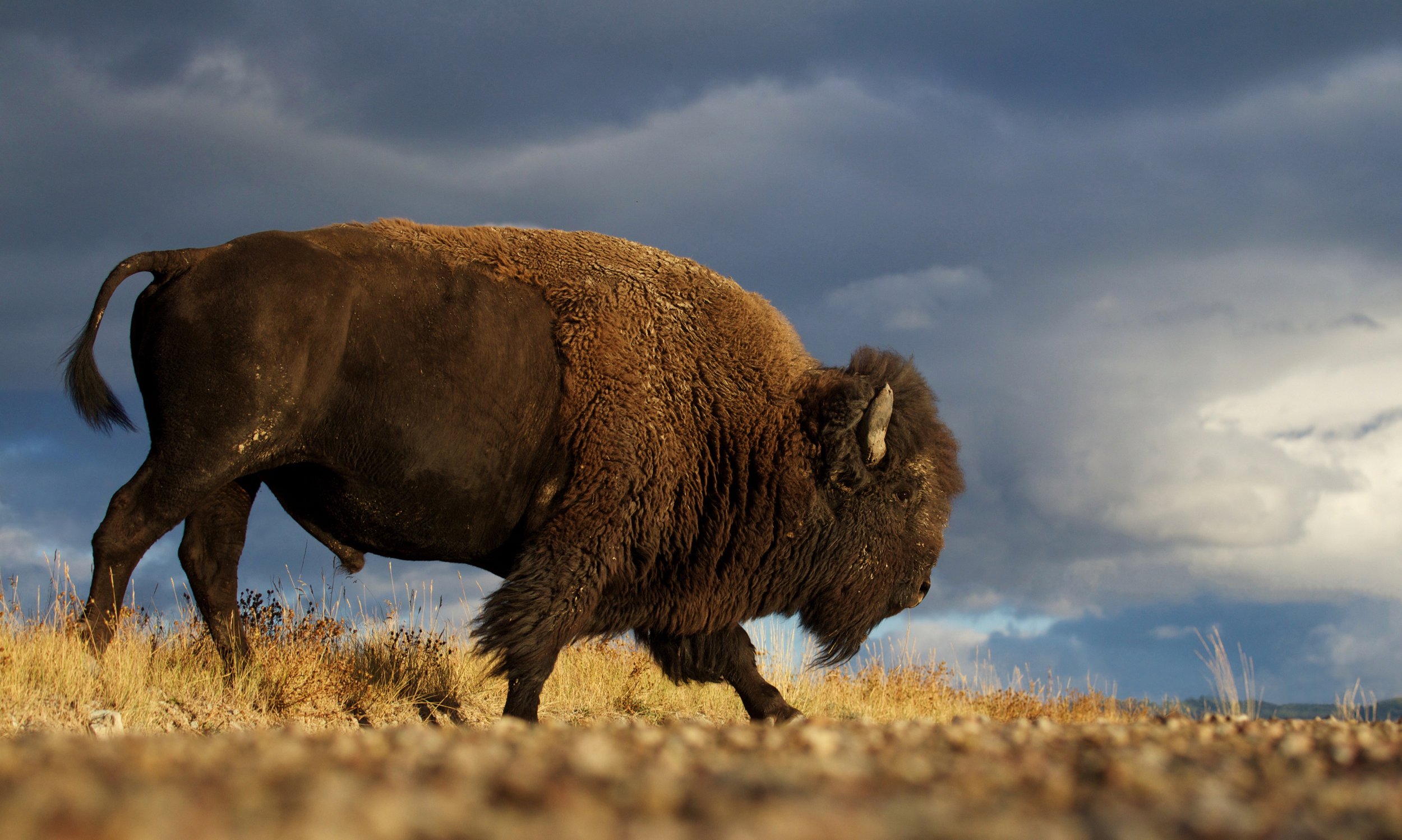
A Wildlife Photographer’s Guide to the Bison Rut
Fieldcraft, Behavior, and Conservation on the Prairie
Written by Jared Lloyd, founder and editor of PhotoWILD Magazine
Before we can talk about these animals, we need to get one thing straight: they are not, and never were, buffalo.
The word buffalo has been stamped into American culture through the buffalo nickel, Buffalo Bill Cody, Buffalo, New York, and even buffalo burgers. Generations of Americans have used the term without a second thought, but scientifically and historically, it’s incorrect. North America never had true buffalo, which are distant cousins of bison – two distinct genera that diverged millions of years ago. The water buffalo (Bubalus bubalis) of Asia and the African buffalo (Syncerus caffer) are animals adapted to very different environments. In the Western Hemisphere it's Bison bison, the largest land mammal in the Americas.
Bison aren’t simply a shaggy horned cow with a bad temper. They’re one of the last survivors of the Ice Age megafauna that dominated the North American plains, an animal shaped by the relentless forces of open grasslands, predators, and cycles of feast and famine. At their peak, somewhere between 30 and 60 million bison thundered across the prairies in herds so vast they darkened the horizon. The sound of their passage – a rumbling tide of hooves and dust – was said to make the earth tremble, leading early explorers to refer to them simply as thunderbeasts.
Those herds are now gone. Today, only around 20,000 still exist in the wild across various national parks and preserves.
The bison rut is the earliest of all ungulates on the continent. By late July and early August, hormonal changes begin to transform the herds. Testosterone surges through the bodies of mature bulls as shortening days signals the start of breeding season. Throughout the rest of the year, bison live in sex-segregated groups. Cows, calves, and young bulls form the vast herds that visitors most often see in places like Yellowstone or the Badlands. Adult bulls, however, spend most of the year either alone or in small bachelor groups away from the herds.
But the rut changes all that. Driven by the ancient evolutionary imperative to breed, the bulls emerge from solitude and return to the herds. They arrive thick-necked and heavy with muscle, their coats matted from wallows and dust, bellies stained from urine-soaked dirt. They are full of swagger. Their eyes are bloodshot, and their bellows, that can carry for miles, begin to ripple across the grasslands.
This is not merely a mating season. It is a tournament in the purest sense. Fewer than one in ten bulls will sire any calves in a given year, and among those, a single dominant bull may father half the calves in a herd. The stakes are unimaginably high, and the battles that determine reproductive success are brutal. Yet the ritual persists, a crucible that has shaped the species for millennia.
Field-Ready Bison Rut Cheat Sheet: Timing, Safety & Behavior
Don’t guess when and how to photograph the rut—get instant access to the full set of field protocols, daily activity windows, safety distances, and the insider cues that pros rely on.
Print it out or keep it on your phone—the infographic guide helps you prepare for peak rut behavior and stay safe, wherever you shoot
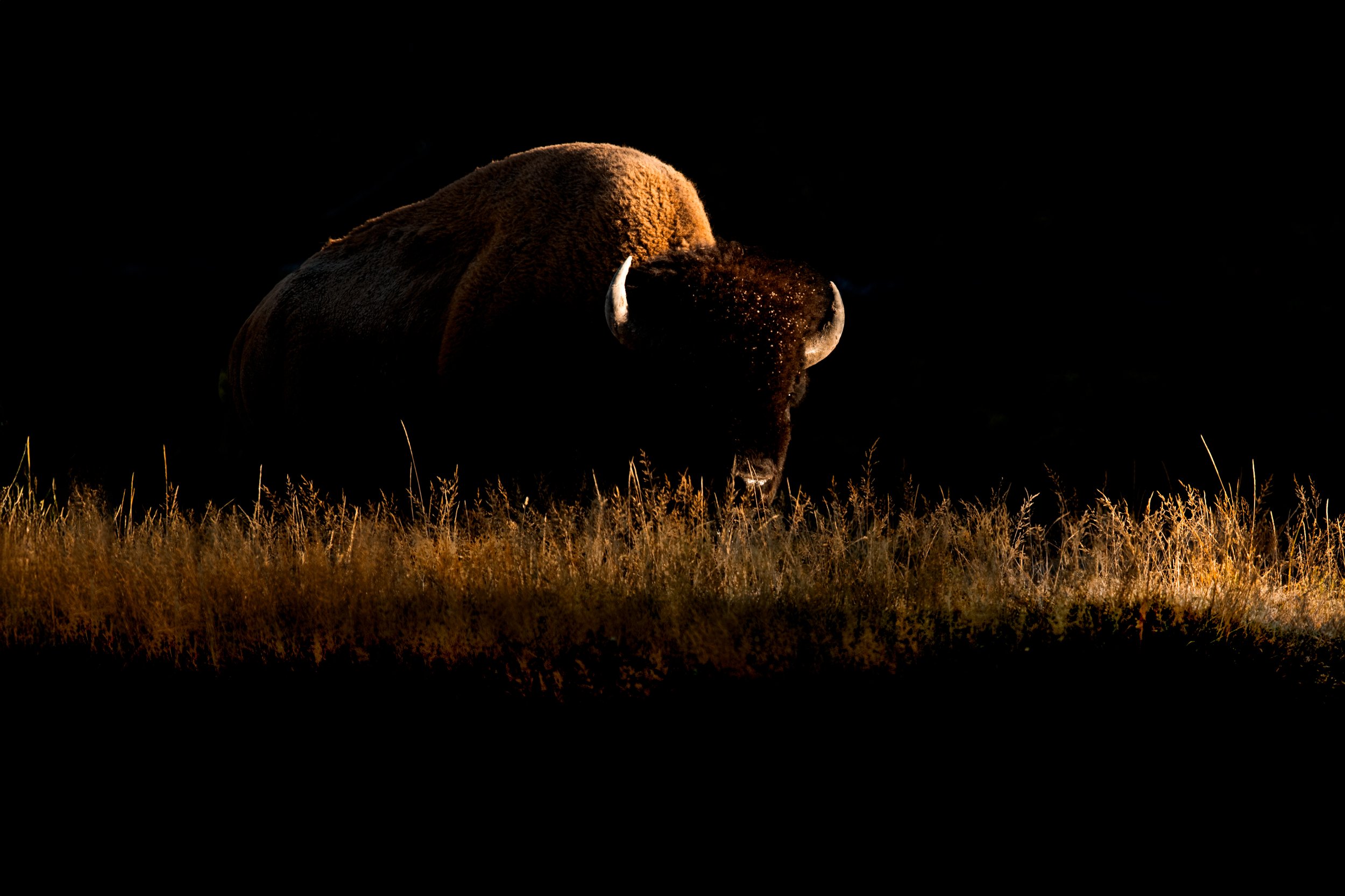
The Annual Cycle
For a species shaped by the vastness of the plains, the bison’s life is a continual negotiation between energy and opportunity. The harsh winters and fleeting summers of North America’s interior grasslands impose a rhythm that governs their physiology, social structure, and breeding behavior.
Unlike some ungulates that live in mixed herds year-round, bison spend most of the year in sex-segregated groups because it is simply more efficient. The cows and calves form the core herds, traveling in large numbers for safety and taking advantage of the best forage. The bulls remain separate, occupying less productive edges of the range. This separation reduces competition for limited resources during the long winter and spring months when the plains are locked under snow or baked into dust.
This rhythm is reinforced by the biology of both sexes. During winter, bison survival depends on conserving energy and maintaining enough fat reserves to withstand brutal cold and scant forage. Bulls, which carry more muscle and less fat than cows, are especially vulnerable to depletion and injury during the rut, so the rest of the year is a period of recuperation. Cows, meanwhile, sustain pregnancies through winter and calve in late spring, timing their offspring to coincide with the flush of new growth.
By early summer, the cows give birth, usually in late April through May, when protein-rich grasses are just beginning to spring up and while predator pressure is relatively low. Calves, reddish in color and called “red dogs,” grow rapidly, and the herds gradually move toward higher-quality grazing areas as the season progresses. But as days begin to shorten, hormonal triggers occur that are induced by the shifting photoperiod. Testosterone builds. And bulls begin to take on the qualities of elephants in musth - restless, aggressive, and driven by surging hormones.
This seasonal cycle is the product of an evolutionary arms race between climate, predation, and reproductive success. By concentrating breeding into a narrow window when the cows are in peak condition and forage is abundant, bison ensure the highest probability of calf survival. But this also creates intense competition among bulls, a fact that defines every aspect of their rut.
In other words, the annual cycle is not simply a social convenience; it is a survival strategy. The long months of solitude and recuperation allow bulls to amass the energy they will burn during a few brutal weeks of fighting and displaying, and it allows cows to choose mates when their own bodies are best equipped to carry a pregnancy through the winter.
The Rut Begins
By late July, the prairie changes. The sun hardens the grass into brittle stalks, the air thickens with heat and dust, and the bison herds begin to churn with a restless energy that is palpable long before the first clashes erupt.
At first, the reemergence of the big males is understated. Bulls linger at the edges of the herd, grazing and watching, sniffing the air for the scent of cows approaching estrus. But soon their intentions become unmistakable. Their bellowing begins — at first low and sporadic, resonant moans that seem to vibrate through the ground more than the air. As competition intensifies, the calls grow louder, longer, and more frequent. Each bull’s voice is unique, and research has shown that these bellows communicate body size, stamina, and aggression to both rivals and potential mates. The largest, most dominant bulls produce calls of lower frequency and longer duration — an unmistakable acoustic signal of fitness. Remarkably, these calls can carry over three miles across the open prairie, allowing bulls to assert themselves across the herd without immediate confrontation.
When a bull identifies a cow in estrus, he moves in behind her, lowering his head and curling his lip — a behavior known as the flehmen response — to detect pheromones that confirm her readiness to breed. If she’s close to ovulation, he guards her closely, following her movements and driving away rivals. This tending phase can last hours or even days, during which the bull eats little and focuses entirely on guarding her.
Confrontations are inevitable. As challengers approach, they circle each other, pawing at the ground, shaking their massive heads, and snorting clouds of dust. If neither backs down, they charge. Heads lowered, they meet with an impact that echoes across the plains. The fights are brief but punishing, and the larger, stronger bull almost always prevails.
It is a tournament in every sense of the word, with an unforgiving hierarchy in which only a few will succeed. Yet even success is fleeting. Injuries, exhaustion, and constant challenges take their toll, and most bulls maintain their position for only a few seasons before being replaced.
For those who witness it, the rut is unforgettable. The air vibrates with bellows and the smell of musk. The sunlight cuts through suspended dust kicked up by fighting bulls. The quiet herds of spring become a battlefield of sound and motion, where the stakes are nothing less than immortality through the continuation of their genetic line.
The Costs of Dominance
To dominate the rut is to gamble with survival.
By the time a bull emerges victorious — having fought off rivals, secured a position near the center of the herd, and tended one or more receptive cows — he is already on the edge of physical exhaustion. The demands of the breeding season strip even the most formidable bulls of their strength, leaving them gaunt, injured, and vulnerable by the time the herds disperse again in late August or early September.
The physiological toll of the rut is staggering.
Studies of rutting bulls in Yellowstone have documented weight losses of up to 20 percent over the course of a single rut. Fat reserves are depleted first, then muscle begins to waste. As a result, bulls emerge from the season visibly diminished with ribs and hip bones protruding, neck muscles sunken, flanks hollowed. Their once-glossy coats are matted with blood, dirt, and urine, their horns chipped and dulled.
The injuries inflicted during the rut are no less severe. Although most fights end quickly, the collisions are powerful enough to crack ribs, tear muscle, and inflict deep puncture wounds. Horn thrusts often leave lacerations around the head, neck, and shoulders. Many bulls carry scars from past seasons, and some die outright — killed by the impact of a rival’s charge or left incapacitated in the wake of a fight.
Even for those who survive the fights, the costs linger. Weakened and emaciated, dominant bulls enter the long winter at a disadvantage. Wolves and grizzly bears — which rarely pose a serious threat to healthy bison — sometimes exploit rut-weary bulls in early autumn, targeting individuals slowed by injury or exhaustion.
The rut favors bulls in their physical prime — usually between six and ten years of age. But as male bison age, injuries accumulate, reflexes dull, and younger, stronger bulls rise to challenge them. Some bulls, having achieved the right to breed once, are never able to reclaim that title ever again. Many others never achieve it at all
The reproductive payoff for those few that do dominate is extraordinary. In some herds, a single bull may sire 40–50 percent of the calves born the following spring, while subordinate and younger bulls are largely excluded from breeding altogether. But that success comes at a cost: a higher risk of injury, a shorter lifespan, and the certainty that they will eventually be replaced by the next generation of contenders.
For the bison, this is the evolutionary bargain of the rut. The species has evolved an extreme form of sexual selection — a high-risk, high-reward strategy where a few males monopolize most of the breeding opportunities, and the majority of bulls never pass on their genes. The scars and battered bodies of these animals are the price of a few weeks of dominance, paid in full each summer on the dust-choked plains.
Know When, Where, and How—Get the Bison Rut Infographic for Predictable Field Success
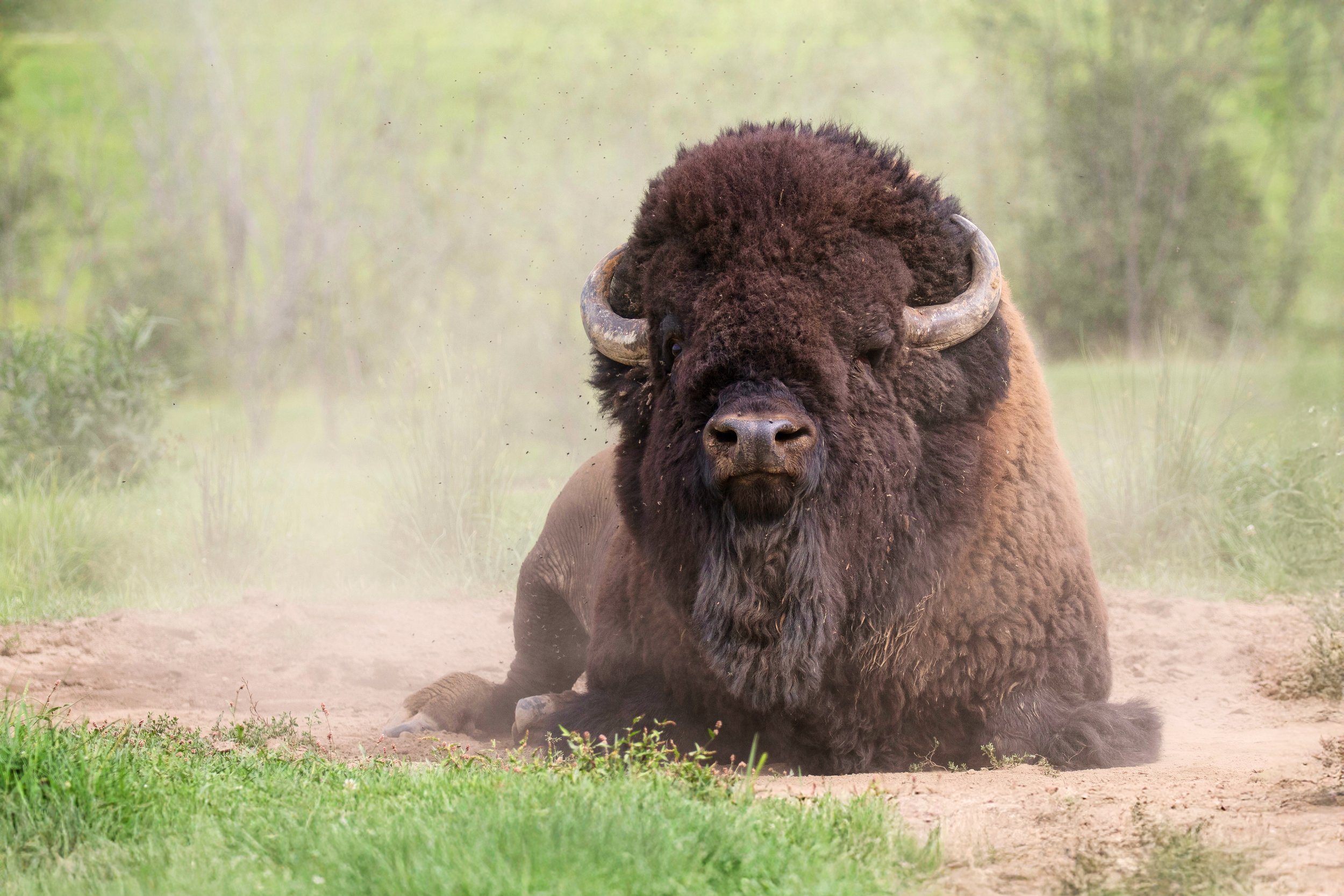
The Power of Choice
For all the dust, muscle, and noise of the bison rut, it would be easy to imagine that its outcome rests entirely on the backs of the bulls. Their clashes seem definitive, the victors obvious. Yet beneath the spectacle of dominance lies another force shaping the next generation: the choices of the cows.
Female bison are not passive prizes to be claimed. Throughout the rut, they exercise agency over who sires their calves, and their behavior actively influences which bulls succeed and which are left pacing the edges of the herd. When a bull identifies a cow approaching estrus, he moves in and begins to tend her, shadowing her movements and driving away any rival that dares approach. This phase can appear like a kind of resigned tolerance on the part of the cow. She grazes, rests, and shifts her weight while the bull hovers behind her, nudging and bellowing, his entire attention fixed on keeping her close.
But tolerance is not consent.
If a cow doesn’t find her attendant acceptable, she has a remarkably effective way of saying so. With a sudden burst of speed, she bolts into the herd, weaving between animals and cutting back and forth across the flow of bodies. The bull has little choice but to give chase, his massive frame pounding after her. But in doing so, he draws the attention of every other mature male in the vicinity. Competitors converge from all directions, intercepting him, circling, and challenging him outright. In this way, the cow incites a cascade of confrontations. Her flight forces the attending bull to prove his fitness — not just by keeping pace with her, but by fending off a gauntlet of rivals who see an opportunity to unseat him.
This tactic serves several purposes at once. It tests the stamina, agility, and determination of the bull while drawing the attention of higher-ranking males who may have been lurking at the edges. Some bulls are worn down by these chases, defeated not by a single rival but by the cumulative pressure of repeated challenges. For the cow, the risk of harassment is offset by the assurance that she is mating with the strongest, most resilient individual available. Researchers have noted that cows often end up mating with bulls who were not their initial attendants, suggesting that this behavior allows them to screen and compare potential sires even in the chaos of the rut.
Even after a successful copulation, the cow retains control over how long the male remains with her. If she chooses, she may move away immediately after mating, leaving the bull to either follow and defend her against further challengers or abandon her and seek another receptive female. In some cases, she may even incite additional tournaments, prolonging the process and ensuring that only the most persistent males succeed.
For wildlife photographers, understanding these dynamics reveals a subtle layer of the rut often lost amid the dust and bellowing. The cows, quiet though they may seem, are the arbiters of genetic success on the plains. And their choices often shape the opportunities for photographing the bison rut.
Historical and Conservation Context
For many thousands of years, the rut played out across an almost unimaginable canvas. When the first humans entered North America, they encountered bison herds that stretched for miles — a seemingly inexhaustible resource that shaped entire cultures and ecosystems. Those herds, composed of tens of millions of animals, moved with the seasons in great riverine migrations, grinding trails into the earth and altering the very structure of the grasslands. The summer rut was a fixture of the plains, a phenomenon so embedded in the rhythms of the land that it likely influenced predator movements, plant growth, and even fire regimes.
All of that changed within a single human lifetime. In the late nineteenth century, market hunting, military campaigns, and habitat destruction reduced the continent’s bison population from perhaps sixty million animals to fewer than a thousand. The slaughter was so complete, so systematic, that it was widely assumed the species would vanish entirely. The herds fragmented into scattered remnants, and the social dynamics of those remaining groups were almost certainly distorted. Bulls that might once have competed in tournaments surrounded by thousands of cows found themselves reduced to defending a handful of females, if any at all. The competitive intensity and complex hierarchies that defined the rut could not have remained unscathed under such pressure.
The recovery of the bison, though incomplete, is one of the better-known conservation stories in North America. Through the efforts of ranchers, conservationists, and a handful of visionary park managers, the species was pulled back from the brink in the early twentieth century. Yellowstone’s herd, which is descended from just a few dozen survivors, became a cornerstone of recovery, and protected areas like the National Bison Range and Wind Cave National Park helped rebuild viable populations elsewhere.
Today, approximately half a million bison exist on the continent, but most are confined to private ranches where they are managed as livestock rather than wildlife. Only about 20,000 live in conservation herds that retain natural social dynamics and ecological roles. Within these herds, the rut still resembles what it must have looked like on the pre-settlement plains, though on a far smaller stage. The bellowing, the wallowing, and battles have endured, encoded in the species over millennia. Yet some researchers have questioned whether the reduced herd sizes and fragmented ranges have subtly altered the intensity or expression of the rut. Smaller groups may limit the number of competitors, diminish the duration of contests, and reduce the genetic diversity of successful bulls.
Climate change and land use continue to shape the bison’s world in ways that could further affect their breeding behavior. Hotter, drier summers may increase the physical toll of the rut, while encroaching development constrains the space available for herds to move and disperse. Some managers have experimented with controlled burns and rotational grazing to mimic the dynamic conditions of the historic prairie, in hopes of preserving not just the species but the ecological drama of which the rut is a central part.
In a sense, the rut has become both a biological and a cultural relic; a rare window into a world that once covered half a continent. Standing on the plains in late summer, the air thick with dust, it is possible to glimpse what was nearly lost and to feel, if only briefly, the scale and ferocity of the wild herds that once ruled here.
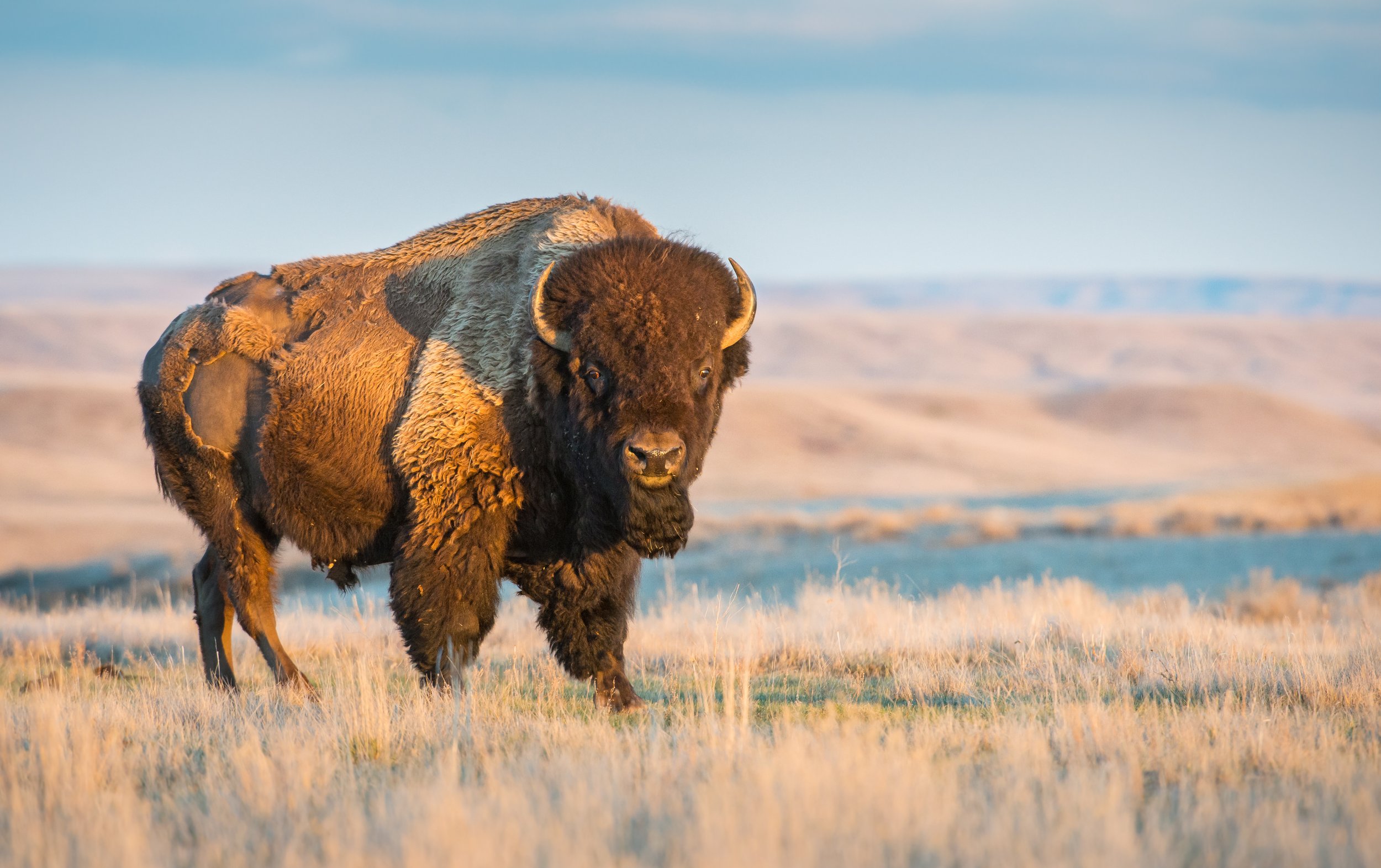
Fieldcraft and Observation
Watching the bison rut up close is one of the most visceral wildlife experiences in North America. It is also one of the most misunderstood and mishandled by photographers. These animals are not merely photogenic subjects but formidable forces of muscle and instinct. Capturing this requires more than a camera and a telephoto lens; it requires an understanding of their language, an awareness of their moods, and a respect for the boundaries they enforce with unmistakable clarity.
For much of the year, bison appear docile, grazing across the prairie in loose herds, largely indifferent to the people around them. Tourists in Yellowstone often stroll within yards of them, oblivious to the fact that a healthy bull can weigh over a ton and sprint faster than a racehorse. During the rut, however, that latent power surfaces. Bulls flooded with testosterone become acutely attuned to any disturbance, their energy focused on rivals, receptive cows — and, at times, anything that intrudes too closely.
For wildlife photographers and observers, reading this change in mood is critical. The signs are subtle at first: a raised tail, halfway up, signals unease; when it flags fully over the back, the decision to charge is already made. Wide, bulging eyes and the rhythmic swinging of a massive head mean the animal is under stress, testing the perimeter of its tolerance. A bison that notices you has already given you more of its attention than you deserve.
Positioning yourself well begins long before you raise the camera. Success comes not from pushing closer, but from anticipating where the herd is going and which bulls are the most dangerous.
Herds follow reliable daily patterns: moving from resting areas to feeding grounds in the morning, circling back to wallowing sites and water, returning at dusk. Recognizing these corridors allows you to set yourself at a respectful distance, letting the animals move into your frame unpressured, behaving naturally.
Even the rhythm of the day dictates your strategy. In the heat of summer, activity compresses to the cooler hours near dawn and dusk, when light is soft and behaviors intensify. During midday, when the herd lies scattered and quiet, there is still much to see for the patient observer: bulls resting in the dust, grooming each other, or testing the air for receptive cows with the tell-tale lip curl.
For those who learn to watch the subtle cues, the bison’s world becomes legible. Their behavior is written in the language of temperature, hormones, and hierarchy. To witness it well is not simply to point a lens, but to read the rhythms of the plains, understanding that even the most explosive confrontations are predictable chapters in a story that has been unfolding for many thousands of years.
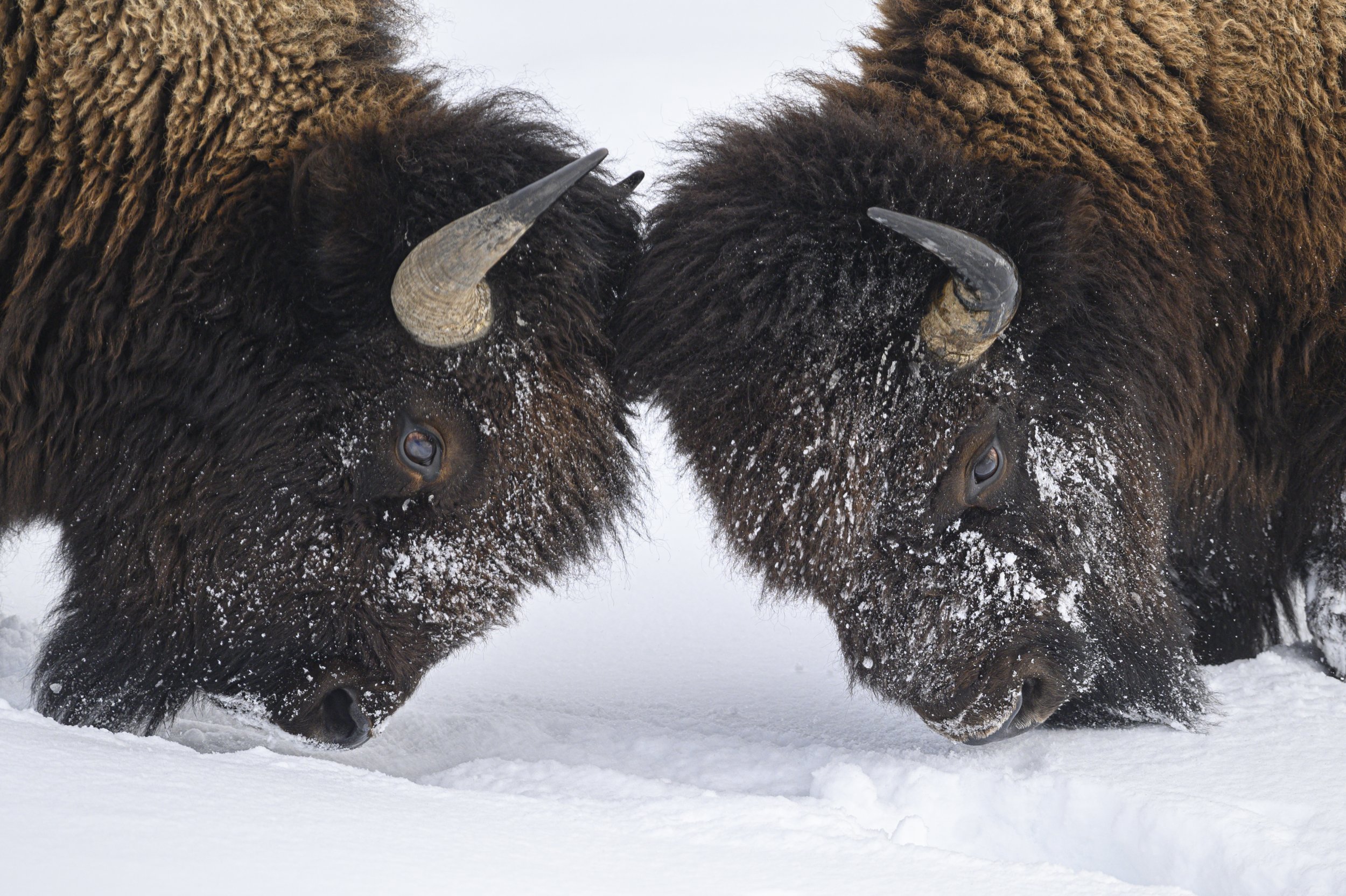
Practical Applications: Where Science and Fieldcraft Combine
The behavioral knowledge explored in this article is not just an academic exercise; it’s a blueprint for those who step into the field with a camera in hand. To photograph bison successfully — and ethically — is to align yourself with their rhythms, anticipate their movements, and respect the boundaries they set. For the patient observer, the convergence of science and fieldcraft transforms fleeting encounters into extraordinary images.
Temperature is among the most reliable predictors of bison activity. Unlike other ungulates that retreat into shade above 54°F, bison remain active even into the low 80s, a legacy of their evolution on the sun-exposed plains. Yet their energy is not limitless. When overnight lows fall below 50°F, they may stay active for hours after sunrise, filling the cool air with dust and sound. As the day warms beyond 70°F, their movements narrow to the crepuscular edges of dawn and dusk. In the heat of midsummer afternoons, they settle into long rest periods punctuated by wallowing, cud-chewing, and quiet social grooming — moments of intimacy that reward a patient photographer willing to wait through the heat. Understanding these thermal thresholds allows you to plan your time around predictable activity windows rather than chasing animals through the midday glare.
Timing matters on broader scales as well. The bison rut begins in late July, peaks in early to mid-August, and tapers through September. By October, only scattered activity remains, and the drama has largely subsided.
Thanks to the bell-curve of the rut, wildlife photographers can build their calendars around the precise types of photographs they are looking for with bison. If you are looking for big bulls in peak fitness, then prepare to be there in late July and early August. If, however, you want more intimate portraits of battle-worn individuals, complete with blood and cuts and broken horns, plan your photography around the end of the rut after countless fights for dominance have taken place.
Likewise, understanding the nuances of bison behavior also prepares you for success in the field. When you find attending males, you know you are looking at a bull who’s ready to fight at a moment’s notice. If a female takes off running through the herd with a bull in tow, you may witness a series of fights, one after another, as that perusing male is forced to fight his way through all other interested suitors.
Though there is always a little matter of luck involved in being in the right place at the right time, as the old saying goes, “chance favors the prepared mind.” This is why understanding the science behind the animal is critically important for success in the field. Understanding even the most basic aspects of the ecology of bison, especially during the rut, will dramatically improve your opportunities in the field.
The Legacy of the Rut
The bison rut is not merely a season of mating. It is a ritual older than the prairie itself, a living testament to the forces that shaped North America long before fences and railroads carved it into pieces. Every summer, when the bulls emerge from their solitude and the herds gather under the weight of the August sun, the landscape seems to revert — if only briefly — to what it once was.
For the bison, this brief, brutal tournament is both a culmination and a beginning. It distills the essence of their evolution: the need to survive the winter, the need to grow strong enough to compete, the need to pass on their genes before age or injury ends their chance. For a few dominant bulls, the rut brings triumph, a fleeting ascendancy, a handful of calves carrying their lineage forward. For most, it brings only exhaustion and frustration, another year waiting at the margins for strength or opportunity to come.
The consequences of the rut ripple beyond the herd. The energy poured into battles and bellows draws predators and scavengers to the fringes. The churned-up prairie alter the structure of the grassland, creating microhabitats for insects and plants. Even the carcasses of defeated bulls nourish the soil and sustain the hidden web of life in the prairie. These connections remind us that the rut is not simply an internal drama within a single species, but a thread in the larger tapestry of the ecosystem. In this way, bison act as a keystone species, their presence and behaviors sustaining the intricate balance of the grassland ecosystem
Beyond the immediate drama of the rut, bison leave their mark on the prairie in quieter, more enduring ways. Every behavior, from grazing to wallowing to moving in masse, shapes the land around them. Their heavy grazing maintains the open character of the grassland, preventing shrubs and trees from encroaching, while their selective feeding patterns create a mosaic of plant heights and species that support a greater diversity of insects and birds. Their hooves churn the soil, loosening it and pressing seeds into the ground, mimicking the effect of fire and rain.
Wallowing, in particular, engineers the prairie in unique ways. The shallow depressions bulls carve into the earth fill with water during storms and snowmelt, creating ephemeral pools that attract amphibians, waterfowl, and a host of invertebrates. These wallows interrupt the otherwise flat grassland, creating microhabitats that persist long after the dust has settled and the bulls have moved on.
For humans, to witness the bison rut is to glimpse a fragment of a lost world. Standing on the edge of a herd as the sun drops and the air vibrates with the resonance of their bellows, you can almost imagine the herds that once stretched to the horizon. The violence and beauty of the rut, the dust, the collisions, the determination of the cows, all evoke the scale and wildness of an America that is largely gone.
In the end, the bison rut is more than a natural history lesson or a photographic opportunity. It is a story of survival written in dust and muscle, played out every summer on the great grasslands of North America. To watch it unfold is to stand witness to one of the last, great expressions of untamed life on the continent.
Locations: Where to Witness the Rut
Although the bison once ranged from the eastern woodlands to the Rocky Mountains and from Canada to Mexico, their modern distribution is a patchwork of conservation herds and private ranches. To watch — and photograph — the rut in its most authentic form, you need to seek out the remaining wild or semi-wild herds where the animals live with minimal interference and retain their natural social structure. Fortunately, several protected areas across the American West still offer excellent opportunities to observe this ancient spectacle.
Yellowstone National Park (Wyoming, Montana, Idaho)
Yellowstone is the most famous place to see wild bison, and with good reason. The park’s herd, numbering around 5,000 animals, is one of the largest free-roaming bison populations in North America. The rut peaks here in August, during the height of tourist season, so expect crowds — both human and bovine. Hayden Valley and Lamar Valley are the premier locations, where large herds congregate on open grasslands surrounded by dramatic scenery. Early morning and evening are best, when the light softens and the animals are most active. Be prepared to work around other visitors, but the photographic opportunities — bellowing bulls silhouetted against the mountains, dust clouds lit by golden light — remain unparalleled.
National Bison Range (Montana)
Nestled between Missoula and Kalispell, Montana’s National Bison Range was established in 1908 specifically to help save the species from extinction. The rolling hills and high prairie here host hundreds of bison in a landscape that feels expansive yet accessible. The rut is intense and highly visible, and the area sees far fewer visitors than the larger national parks. In August, the late summer light is rich, the grasses golden, and the bulls often wallow in the open where they can be photographed against sweeping backdrops.
Henry Mountains and Book Cliffs (Utah)
Utah offers one of the more remote and rugged opportunities to photograph the rut. The Henry Mountains herd — descended from Yellowstone transplants in the 1940s — roams a wild, mountainous landscape largely unaltered by development. Similarly, the Book Cliffs herd inhabits remote canyon country near the Colorado border. Both herds are less habituated to people, and accessing them can require a high-clearance vehicle, careful planning, and patience. For those willing to put in the effort, the rewards are extraordinary: bison moving through juniper-dotted hills, red rock formations, and a sense of solitude rare elsewhere.
Badlands National Park and Wind Cave National Park (South Dakota)
South Dakota’s parks offer a quieter alternative to Yellowstone. Badlands National Park’s herd ranges across striking, eroded buttes and mixed-grass prairie, a visually distinctive backdrop. Wind Cave National Park, just 70 miles away, protects one of the oldest conservation herds in existence, descended from a handful of survivors introduced here in the early 20th century. Both parks see fewer visitors during the rut than Yellowstone, making it easier to move around and position yourself without competing for space. The smaller herds also mean that interactions can feel more intimate, and the varied topography allows for creative compositions.
Tallgrass Prairie National Preserve (Kansas)
For a glimpse of what the historic prairie might have looked like at its peak, head to central Kansas. The Tallgrass Prairie National Preserve protects a rare remnant of tallgrass ecosystem, once the most extensive prairie type on the continent. Its bison herd is smaller than in the western parks, but the setting is unique: shoulder-high grasses shimmering in the wind, wildflowers dotting the slopes, and dramatic evening skies. The rut here tends to be less crowded than at Yellowstone or the Badlands, and the tall grass itself adds a distinctive element to compositions — sometimes obscuring all but the head and hump of a bellowing bull.
Elk Island National Park (Alberta, Canada)
North of the border, Elk Island National Park protects both plains and wood bison. While wood bison occupy different ecological niches and exhibit some behavioral differences, the rut remains dramatic and worth observing. The park’s relatively small size and accessible road network make it easy to find and follow the herds during peak season.

FIELD NOTES
Field Notes is our free email dispatch for wildlife photographers who care about behavior, ecology, and the real work behind the image.
Delivered weekly. No fluff. Read by over 20,000 serious wildlife photographers around the world.
